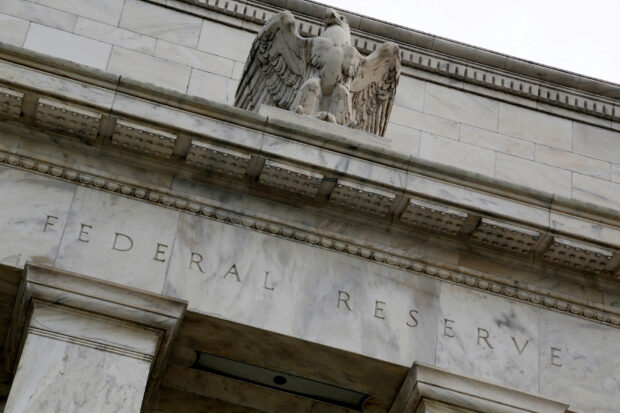
An eagle tops the U.S. Federal Reserve building’s facade in Washington, July 31, 2013. REUTERS/Jonathan Ernst/File photo
WASHINGTON -Federal Reserve policymakers look increasingly comfortable closing out the year with U.S. interest rates on hold and the clock ticking on how soon to deliver a first rate cut as they try to engineer a “soft landing” for the economy.
“Inflation rates are moving along pretty much like I thought,” Fed Governor Christopher Waller, a hawkish and influential voice at the central bank, told the American Enterprise Institute think tank on Tuesday.
“I am increasingly confident that policy is currently well positioned to slow the economy and get inflation back to 2 percent,” he said, and also “reasonably confident” of doing so without a sharp rise in the unemployment rate, now at 3.9 percent.
If the decline in inflation continues “for several more months … three months, four months, five months … we could start lowering the policy rate just because inflation is lower,” he said. “It has nothing to do with trying to save the economy. It is consistent with every policy rule. There is no reason to say we will keep it really high.”
READ: US consumer prices unchanged; core inflation slowing
Rate hike still a possibility
Additional Fed rate increases remain a possibility if upcoming data includes an unexpected resurgence of price pressures, he said. And an unforeseen shock could “blow up” the soft-landing scenario, he said.
But overall it was a shift in tone that appeared to start a countdown on a long-expected pivot.
“The reaction function to lower rates in response to lower inflation is not surprising,” wrote Karim Basta of III Capital Management. “Putting a clear time frame on it is.”
Bond yields fell after the remarks, and traders moved to price rate cuts starting in May and dropping more than a full percentage point in 2024.
The Fed held its benchmark overnight interest rate steady in the 5.25 percent-5.5 percent range at the end of its Oct. 31-Nov. 1 policy meeting, and analysts overwhelmingly expect the same outcome at the Dec. 12-13 meeting.
READ: Fed keeps rates unchanged, Powell hedges on possible end of tightening
Waller’s comments included the caveats that are now standard in public appearances by Fed officials.
“Inflation is still too high, and it is too early to say whether the slowing we are seeing will be sustained,” he said. “There is still significant uncertainty about the pace of future activity, and so I cannot say for sure whether the (Federal Open Market Committee) has done enough to achieve price stability.”
This week marks the final chance for Fed policymakers to set out their views publicly before their usual pre-meeting communications blackout goes into effect.
Fed Chair Jerome Powell will likely have the last word with remarks on Friday at Spelman College in Atlanta.
Inflation goal
By the Fed’s preferred measure, the personal consumption expenditures price index, inflation has dropped from a high of 7.1 percent last summer to a recent reading of 3.4 percent.
The Fed targets 2 percent inflation, and policymakers chalk up the progress so far to a combination of improvements in the supply of both goods and labor after pandemic-era distortions, as well as to the restrictive effect of sharply higher borrowing costs after the Fed drove its policy rate up 5.25 percentage points over 18 months.
To Chicago Fed President Austan Goolsbee, there is definitely some concern of overdoing it.
“Once you believe that you are on the path to get inflation to target, then the amount of restrictiveness that you need to apply needs to be less,” he said in an interview Tuesday with Marketplace. “Anybody who cooks a turkey knows that you’ve got to pull it out of the oven before it’s to the point where you want it to be, because it’s going to have residual heat.”
Speaking at a Utah Bankers Association meeting in Salt Lake City, Fed Governor Michelle Bowman sought to keep alive the possibility of another rate hike, raising a series of questions about the durability of progress on inflation.
READ: US Fed could hike rates again if ‘appropriate’ – Powell
“My baseline economic outlook continues to expect that we will need to increase the federal funds rate further to keep policy sufficiently restrictive to bring inflation down to our 2 percent target in a timely way,” Bowman said.
But even Bowman stopped short of outright calling for a further increase in the policy rate. She said, like Waller and Goolsbee, that further Fed action will depend on economic data.
Healthy economic data
New inflation data will be released on Thursday, and policymakers will also have a fresh monthly jobs report and other data in hand before they gather next month.
Waller pointed to healthy recent data that have already moved in the Fed’s direction, with consumer prices coming in flat in October, retail spending weakening, and a slow easing in wage growth.
The job market remains “fairly tight” and bears watching, he said, while a recent drop in long-term market interest rates has tempered some of the credit tightening the Fed relies on to slow the economy.
But long-term interest rates “are still higher than they were before the middle of the year, and overall financial conditions are tighter, which should be putting downward pressure on household and business spending,” Waller said.

